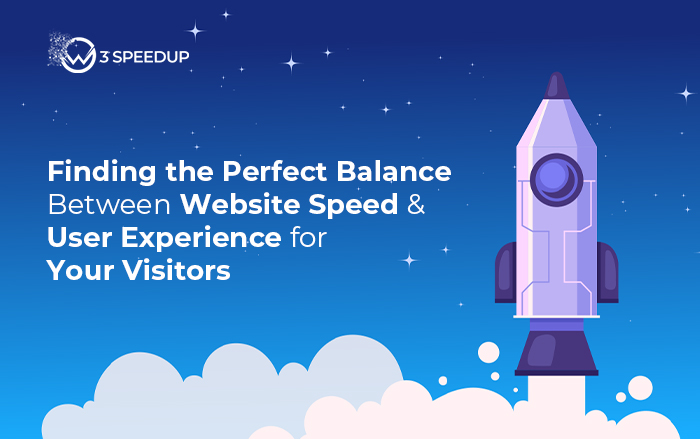In today’s fast-paced world, speed matters. People want everything at once, and that’s especially true on the Internet. Visitors to your website are no exception. They expect your website to load quickly and won’t hesitate to walk away when it doesn’t. However, focusing solely on speed can negatively impact user experience, leading to frustration and ultimately higher bounce rates. The challenge is finding the perfect balance between website speed and user experience. This article discusses tips and techniques for achieving this balance.
What is website speed?
Website speed refers to how quickly a website loads and is an important aspect of user experience. Slow load times can be frustrating and visitors may leave your site before seeing what you have to offer.Google also takes site speed into account when ranking websites. important for search engine optimization (SEO) purposes. Factors Affecting Website Speed
Several factors can affect website speed. Here are the most common ones:
1. Web hosting:
The type of web hosting you choose can have a big impact on the speed of your website. Shared hosting is cheaper, but it means your website shares resources with other websites on the same server, which slows down your website. If you can afford it, opt for dedicated or VPS (Virtual Private Server) hosting, which offers dedicated server space that is much faster than shared hosting.
2. Website design:
Complex website designs with many images and videos can slow down your website. Additionally, using too many plugins and scripts can also slow down your website, so try to minimize your use of plugins and scripts and only use what you need. It also uses a website design template that is optimized for speed.
3. File size:
The size of your website’s files also affects speed. Large image and video files take a long time to load, which can be a problem for visitors with slow internet connections. Optimize your site’s images and videos to be as small as possible without sacrificing quality.
4. Website traffic:
The number of visitors to your website also affects speed. Sudden spikes in traffic can slow down or crash your website. Make sure your website hosting can handle the expected number of visitors. We also use a Content Delivery Network (CDN) to distribute your website’s files to servers close to your visitors, improving your website’s speed.
What is user experience?
User Experience (UX) refers to how visitors interact with her website. A great user experience means that visitors can easily navigate your site, find what they are looking for, and perform the intended action such as clicking all over the website.
Several factors can affect the user experience. Here are some of the most important ones:
1. Navigation:
Clear and easy-to-use navigation menus are essential to a good user experience. Visitors should find what they are looking for quickly and easily. Make sure your navigation is intuitive, easy to find, and consistent across your pages.
2. Content:
Your website content should be attractive and relevant to your visitors. It should also be easy to read and understand. Use headings, subheadings, and bullets to break up long sections of text. Also, make sure your content is free of errors and grammatical errors.
3. Visual design:
The visual design of your website should be attractive and reflect your brand. Additionally, the use of images and videos can enhance the user experience. Use a consistent color scheme, typography, and visual style throughout your site to create a cohesive and visually appealing design.
4. Mobile optimization:
Mobile With more and more people using their devices to browse the web, mobile optimization is essential for a good user experience. Your website should be optimized for mobile devices. H. It should be easy to navigate, load fast, and look great on small screens. You can achieve mobile optimization by using responsive design or creating a mobile-only version of your website.
*Tips for Achieving Perfect Balance
Now that we’ve seen the factors that affect site speed and user experience, let’s take a look at some tips for striking the perfect balance.
1. Use a fast web host:
As mentioned earlier, web hosting can have a big impact on the speed of your website. Choose a web host with fast load times and good uptime. If you have the budget, consider using a dedicated or VPS hosting plan. Optimize your image:
Large image files can slow down your website, so optimizing them is important. Use image compression tools to reduce file size without sacrificing quality. Also, use web-optimized image formats such as JPEG and PNG.
2. Minimize plugin:
Plugins can add functionality to your website, but they can also slow it down. Make sure to use only essential plugins and update them regularly. Remove plugins you no longer need.
3. Using Content Delivery Network:
A content delivery network (CDN) can improve the speed of a visitor’s website by distributing his website’s files to servers that are close to him. This reduces the distance between your website and your visitors, making your website faster.
4. Optimize website design:
Simplify your website design by using fewer images, scripts, and plugins. Use a website design template optimized for speed. Also, make sure your website is mobile-friendly with a clean and intuitive navigation menu.
Besides the technical aspects of website optimization, good customer service also contributes to the user experience. Have a clear and easily accessible contact page, respond quickly to customer inquiries and feedback, and collect customer feedback regularly to continuously improve your website and customer service.
So, website speed and user experience are both important factors for website success. Faster load times are essential, but focusing solely on speed can negatively impact the user experience. The challenge is finding the perfect balance between the two. Factors such as web hosting, website design, file size, and website traffic can affect website speed, while navigation, content, visual design, and mobile optimization all affect user experience. may give. To strike the perfect balance, website owners should use fast web hosts, optimize images, minimize plugins, use content delivery networks, and optimize website design. must be converted. By following these tips, website owners can improve website speed and user experience, resulting in better visitor engagement, better SEO rankings, and higher conversions. Remember, a fast website with a great user experience can make a big difference in the success of your online business.



